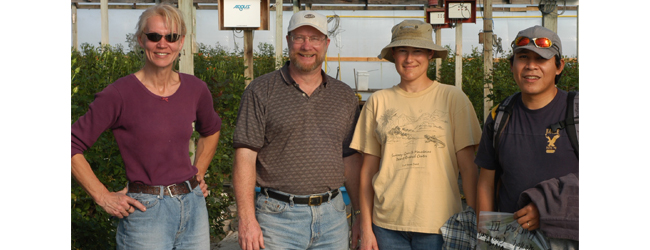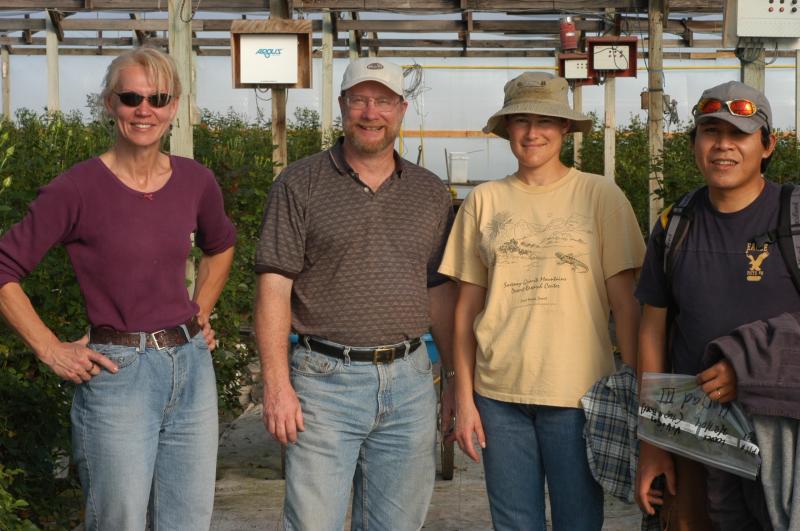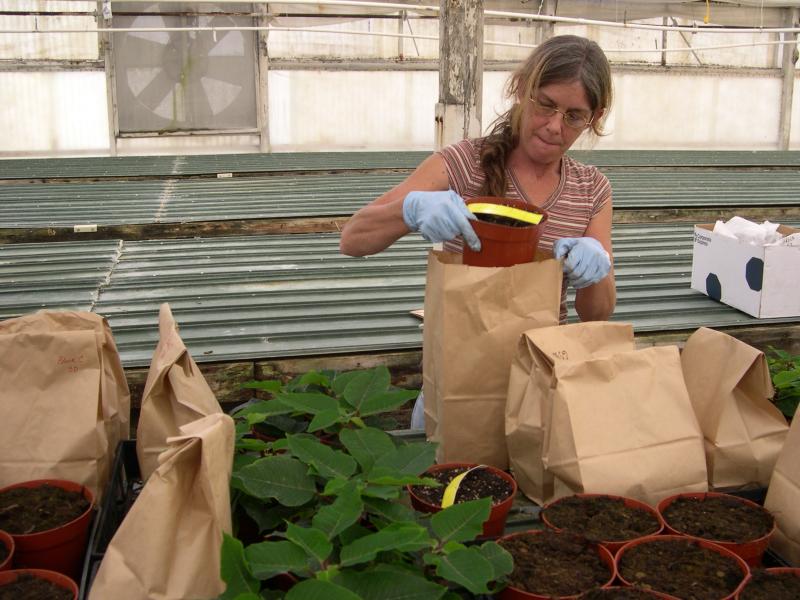
The University of California Serves the Ornamental Plant Production Industry
Editors note: This is the first article in a series on research and education programs being performed at the University of California.
 James Bethke and staff working with local rose growers on mite resistance issues.
James Bethke and staff working with local rose growers on mite resistance issues.
The first and second Organic Acts passed in 1866 and 1868 allowed the creation of state universities controlled by a Board of Regents, and California led the way with its internationally renowned network of public colleges and universities.
One of the three college networks in California became the University of California (UC) system, an expansive and high-quality system of affordable, public, higher education that includes: 10 campuses, five medical centers, three national labs, and the Division of Agriculture and Natural Resources (Cooperative Extension).
The 10 campuses in chronological order include Berkeley (1868), San Francisco (1873), Davis (1908), Santa Barbara (1909), Los Angeles (1919), Riverside (1954), San Diego (1960), Irvine (1965), Santa Cruz (1965) and Merced (2005). Three of the ten campuses are considered land grant institutions, UC Riverside, UC Berkeley and UC Davis. Within the land grant institutions are colleges and organizations that do research on ornamental plants, and include departments such as entomology, pathology, plant sciences, nematology, etc.
The University of California Division of Agriculture and Natural Resources consists of the University of California Cooperative Extension (UCCE) and a network of Agricultural Experiment Stations. The Division includes campus-based or experiment station academic specialists and county-based academic advisors. The county-based advisors serve as the local experts delivering research and extension to the local communities.
Research and Education of the Ornamental Plant Production Industry
Within the UC system, there are many Agricultural Experiment Station (AES) faculty, specialists and advisors who assess the needs of the industry conduct both traditional and applied research on ornamental plant production issues, and extend the results to growers and allied pest management professionals.
Maintaining communication and cooperation among the faculty, specialists and advisors who work on ornamental plants is a priority. In order to do this, we have formed a workgroup that meets regularly, shares new research results, and proposes and cooperates on original research and creative extension education.
This group is called the University of California Nursery and Floriculture Alliance (UCNFA), and members of this alliance include a great many scientists, but the following academics from the three land grant institutions and UCCE play a prominent role in the UC system : James A. Bethke (UCCE), Dr. Jim Downer (UCCE), Dr. Richard Evans (UC Davis), Dave Fujino, (UC Davis), Dr. John Kabashima (UCCE), Dr. Heiner Lieth (UC Davis), Dr. Don Merhaut (UC Riverside), Dr. Loren Oki (UC Davis, UCCE), Dr. Michael Parrella (UC Davis), Dr. Michael Reid (UC Davis) and Steve Tjosvold (UCCE).
This is the first in a series of articles outlining research and education in the area of ornamental plant production at the University of California, and many of the academics mentioned above will provide a follow-up article on their research and important results. They include the following:
Dr. Michael Parrella's laboratory is developing and implementing IPM strategies for the ornamental plant production industry with an emphasis on biological controls. They focus on understanding the relationship of the pest to the crop (including its unique production practices) to the environment and to its natural enemies.
Loren Oki's research is dedicated to a range of horticultural issues affecting water quality and conservation in both urban and commercial production environments. His aim is to provide practical solutions for real problems faced by gardeners, public agencies and growers through research, outreach and technology refinement. Dr. Oki's group is examining how slow sand filtration and other natural water treatment systems remove plant pathogens, including Phytophthora ramorum, the organism that causes Sudden Oak Death disease, and other pollutants from nursery irrigation runoff. The treated water could then be safely reused for irrigation.
Steve Tjosvold has been battling invasives of great significance to the ornamental plant industry in north central California. The two serious pests that dominate his research and education are the light brown apple moth and Phytophthora ramorum. These two pests have severely impacted the nursery industry in his coverage area by closing markets, increasing costs and significantly increasing pesticide use.
Don Merhaut's laboratory emphasizes the physiological and horticultural aspects of plant production, focusing on the optimization of nutrient use efficiency for nursery and greenhouse crop production. Another portion of his program encompasses the development of Best Management Practices (BMPs) for ornamental plant production, and they include irrigation efficiency, fertilizer use efficiency, infrastructural considerations and integrated pest management (IPM). With these programs, Dr. Merhaut has been successful in helping growers comply with new state regulations associated with the mitigation of nutrient and pesticide runoff.
James A. Bethke's program emphasizes the IPM of major pests of floriculture and nursery production. Additionally, some of the most vexing issues in ornamental production include the regulatory restrictions and mandates associated with very serious invasive pests. Research on these invasives is lacking and in many cases there is almost nothing known about some of these pests. Some of the major invasive pests that he has identified solutions for, and participated in the development of best management practices for, include the serpentine leafminer, the sweetpotato whitefly (A, B and Q biotypes), European pepper moth, Diaprepes root weevil, Asian citrus psyllid, myoporum thrips and the glassy-winged sharpshooter. In addition, Bethke's program evaluates new and old pesticides in efficacy trials throughout the year.
Steve Tjosvold provides a field workshop on the effective application of pesticides in nurseries.
UCNFA Extension Education
Part of our duties is to continuously educate the local ornamental plant producers about best production and management practices in order to maintain viability and profitability of the industry. To that end, we have produced a web page with original content and a calendar of events informing producers of local workshops, seminars and training, and we produce UCNFA News, which is an archived, periodic publication focusing on current issues and new research in subject areas of interest to the nursery and floriculture industry. We also provide a consistent suite of educational programs in English and Spanish that include, but are not limited to, the following: The ABCs of Plant Pathology, the ABCs of Fertilizers and Plant Nutrition, ABCs of Horticulture, ABCs of Nursery and Greenhouse Pests, Biological Control in Ornamental Plant Production, Irrigation Management Efficiency and Water Conservation in Nurseries, Effective Use of Pesticides, Erosion and Pesticide Runoff Workshop, etc.
An Example of Addressing a Major Issue
We conduct periodic assessments of the needs of the industry in order to gain knowledge of the current issues they face, and the surveys are consistent. The No. 1 issue is always pest management largely because an entire crop can be lost due to the presence of a pathogen or arthropod, and many times when they are detected, it's too late. So, if a grower wants to sleep at night, they will often treat their plants for peace of mind. Therefore, many of our studies are associated with pest management.
However, there are many other issues that growers face. For instance, cut flower growers are interested in advances in post-harvest technology, and Dr. Michael Reid of the University of California Davis is well known for his work in post harvest quality and longevity. For many of the growers who bring in plant material from out of state, off shore, or ship out of the county or state, their major concerns are related to invasive pests and the associated inspections and regulations.
Again, they stand to lose an entire shipment or they may incur burdensome costs related to the invasion. Research and education related to invasive pests is also a focus of most of the academics associated with ornamental plant production, especially those who work in Cooperative Extension at the local level.
 Fungus gnat control trial on poinsettias using biologicals in comparison to conventional insecticides.
Fungus gnat control trial on poinsettias using biologicals in comparison to conventional insecticides.
The following is an example of how we came together to address a current industry issue. California faces an unprecedented drought, and the governor has mandated water use by 25-35 percent, but agriculture water use is exempt.
However, the vast majority of ornamental plant producers in southern California are in urban areas on small acreage, use local municipal water rather than well or agricultural water and fall under the order. The solution to this problem required a collaboration of the California Farm Bureau, the University of California Cooperative Extension and the local growers.
UCCE was able to address the issue with the local municipal water districts by producing a Best Management Practice for Farm Potable Water Use (BMP) document. The growers who were already following the BMPs would be identified by the water district as an agricultural producer, and would be exempt from the rule. This sounds simple, but the water districts are under strict orders to comply with the reductions and demonstrate that they had complied with the additional reduction. Once agricultural producers are removed from the mandate, the additional reduction would then fall to urban residents. No one is happy, but ornamental plant production will continue.
This is not the first time California has experienced drought, so we recognize the need to address water use efficiency in floriculture and nurseries throughout the state. As a team, our floriculture and nursery workgroup collected all of the recent and past research and education materials on drought and irrigation efficiency technology, and went on a roadshow to present the information in seminars entitled, "Irrigation Management Efficiency in Nurseries" and "Irrigation Sensor Technology Workshop." As anticipated, the programs have been well attended.
The UCNFA will continue to serve the industry's needs and extend the information so that producers will benefit nation wide. The next articles in our series will present information that can be useable in a practical way and will identify academics that can be contacted as a resource.
The University of California Serves the Ornamental Plant Production Industry









 Video Library
Video Library 


















